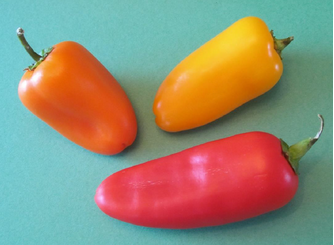Don Mercer
Recently, I began working on a project which included the objective of adding value to a region’s local agricultural crops. One way to do this is through a minimal processing approach such as drying. Drying has the advantage of increasing the storage life of the product while removing much of the weight, making it easier and more economical to ship to more distant markets.
The first step in any activity such as this is to see what crops are grown in the area and then select the ones that might be the most appropriate candidates for further work. It soon became apparent that peppers were a high priority for everyone involved.
I originally envisioned working with sweet peppers similar to those we grow in our garden and enjoy eating sliced or in salads. What a surprise when I asked my colleagues about specific varieties of interest, and encountered names such as Moruga red, Cardi green, and West Indies Red (or Scotch Bonnet). A quick check soon revealed these were no wimpy sweet garden-variety peppers. One Moruga red variety, dubbed the “Scorpion”, is a contender for the dubious distinction of being the world’s hottest peppers. The other two are no light-weights either when it comes to setting your taste buds on fire. On the Scoville Heat Unit (SHU) comparison scale, the “Scorpion” is rated as having 1.5 to 2.0 million SHUs. The Scotch Bonnet pepper typically has about 350,000 SHUs and is also considered among the top-ten hottest peppers in the world. The Cardi green pepper which is in the same ballpark is not for the faint of heart either. Just for comparison, jalapeno peppers and tobasco sauce come in at a rather mild 8,000 SHUs.
This may lead you to wonder how the heat, or piquancy, of various peppers can be measured in a quantifiable manner. Back in 1912, an American pharmacist named Wilbur Scoville developed a systematic approach which bears his name. In the Scoville test, alcohol is used to extract the heat-inducing chemical “capsaicin” from a sample of dried pepper. A specified volume of alcohol extract containing the capsaicin is then mixed with a sugar-water solution. A panel of trained tasters checks increasingly diluted samples of the extract until they can barely detect any heat. Bell peppers or other sweet peppers which have no perceptible heat, have been given a rating of zero on the SHU scale. In order to be reduced to this “zero” level, extracts of the Scorpion pepper must be diluted by a factor of about two million volumes of sugar solution to one volume of alcohol extract. Hence the rating of two million SHUs.
Due to their reliance on human tasters who can easily become fatigued, a certain degree of subjectivity can be imparted to these tests. More sophisticated scientific methods using chromatographic techniques have been developed to measure the levels of capsaicin present in various peppers. Capsaicin concentrations can now be accurately compared between hot peppers, and assigned a more reliable SHU rating. I also came upon numerous YouTube videos showing people chewing Moruga “Scorpion” peppers and swallowing them. One Australian fellow went on to explain the sensation – after his glasses fogged up and his tongue started to go numb. It definitely begs the question, “Why would anyone ever do such a thing?” If you don’t raise your expectations too high, you may find some of these videos tempting to watch. Please don’t try it at home though, folks! Just handling such hot peppers can be a problem if the juice gets on your hands. It can be especially painful if you touch your eyes, or inadvertently put your fingers to your mouth. Some additional interesting facts about hot peppers include that most of them originated in Trinidad and Tobago. The hottest peppers were valued because of their ability to prevent food from spoiling – which says a lot for their potency. There is even a pepper called the “Seven Pot” or “Seven Pod”. If you cut this pepper pod into seven slices, you can use one slice to season a pot of stew to a relatively high heat level. So, instead of buying seven individual tamer peppers for seven pots of stew, you can do the job with just one super-hot pepper.
Right now, my main concern is drying these things safely, and whether or not they warrant some sort of hazardous material warning symbol on the finished product label. As for my own personal preference, I’m going to stick with sweet peppers and avoid the agony witnessed in the on-line videos.

Sweet peppers such as these have “zero” heat units
Dr Don Mercer is Associate Professor, Food Science, Kemptville Campus of University of Guelph, Guelph, Ontario K0G 1J0, Canada; e-mail: dmercer@uoguelph.ca . Permission to reproduce is gratefully acknowledged.
IUFoST Scientific Information Bulletin (SIB)
FOOD FRAUD PREVENTION